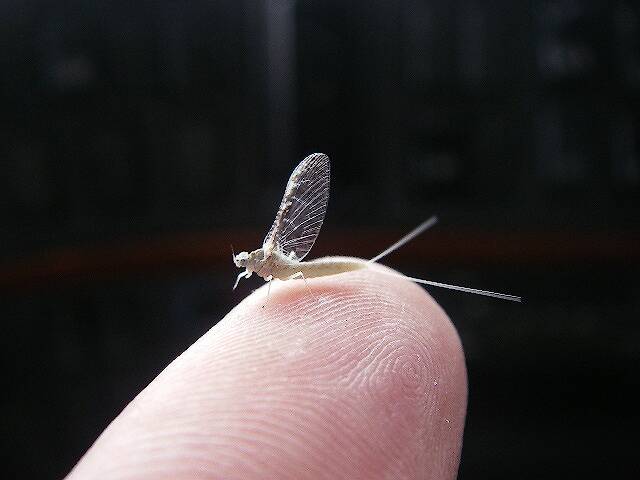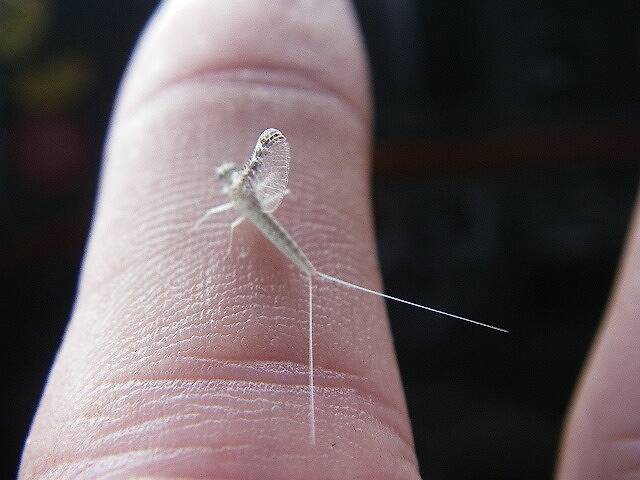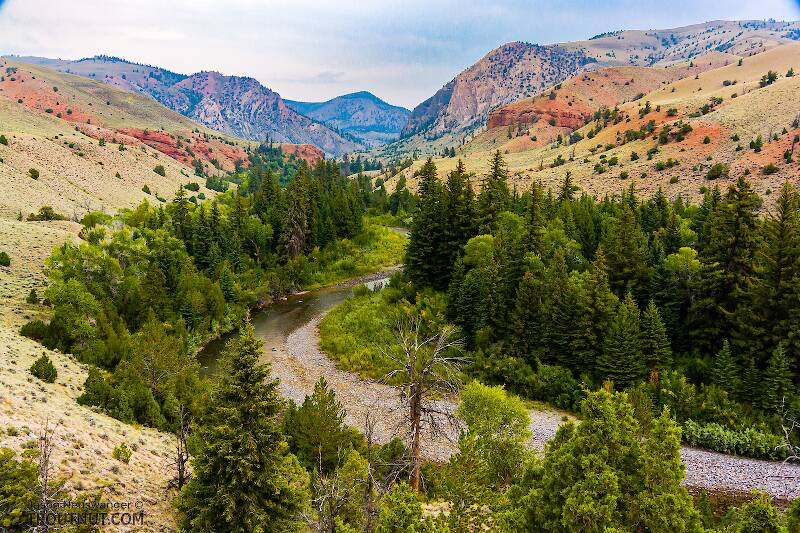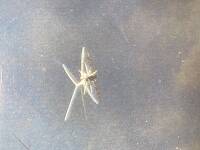
Salmonflies
Pteronarcys californica
The giant Salmonflies of the Western mountains are legendary for their proclivity to elicit consistent dry-fly action and ferocious strikes.
Featured on the forum

I was not fishing, but happened to be at an unrelated social event on a hill above this tiny creek (which I never even saw) when this stonefly flew by me. I assume it came from there. Some key characteristics are tricky to follow, but process of elimination ultimately led me to Sweltsa borealis. It is reassuringly similar to this specimen posted by Bob Newell years ago. It is also so strikingly similar to this nymph from the same river system that I'm comfortable identifying that nymph from this adult. I was especially pleased with the closeup photo of four mites parasitizing this one.

Troutnut is a project started in 2003 by salmonid ecologist Jason "Troutnut" Neuswanger to help anglers and
fly tyers unabashedly embrace the entomological side of the sport. Learn more about Troutnut or
support the project for an enhanced experience here.


Calloway on Jul 24, 2008July 24th, 2008, 8:09 am EDT
Another Mayfly I need to have identified it was found in Fort Royal, VA.
Thanks for the help Guys
Thanks for the help Guys
GONZO on Jul 24, 2008July 24th, 2008, 8:25 am EDT
This appears to be a female Callibaetis spinner.
Calloway on Jul 24, 2008July 24th, 2008, 4:35 pm EDT
Could it be a cream cahill?
GONZO on Jul 24, 2008July 24th, 2008, 4:58 pm EDT
Well, that would be a good imitation. The pale cross-veins and dark mottling along the leading edge of the wing are Callibaetis traits. The hindwings, although not apparent in the photo, would be quite small. On what is usually thought of as a "cream cahill" (Maccaffertium spp.), dark marking on the wings consists of dark cross-veins, the legs usually have some banding around the middle of the femur, and the hindwings would be larger. (Forewings and legs would probably appear proportionally larger as well.)
Callibaetis are usually more common around lakes and ponds, although some streams and rivers have small populations.
PS--You can compare your photo to this photo of a female Callibaetis that might be the same species:
http://bugguide.net/node/view/129515/bgimage
Callibaetis are usually more common around lakes and ponds, although some streams and rivers have small populations.
PS--You can compare your photo to this photo of a female Callibaetis that might be the same species:
http://bugguide.net/node/view/129515/bgimage
GONZO on Jul 24, 2008July 24th, 2008, 6:13 pm EDT
Thanks for the additional image, Keith. You can see the sparse, pale cross-veins a bit better in the new photo (top). Notice that the hindwings are so small that they are not apparent in either photo.
Phillyfired
Posts: 8
Posts: 8
Phillyfired on Jul 25, 2008July 25th, 2008, 12:23 pm EDT
Gonzo quick question what type of nymph/larva would you recommend to represent the PMD going to 3rd meadow of slough creek next week for 7days need to have everything possible. You have been a great help in learning
Thanks
Mark A. Pryor
Phila Fire Dept.
Trk 34
Thanks
Mark A. Pryor
Phila Fire Dept.
Trk 34
GONZO on Jul 25, 2008July 25th, 2008, 12:50 pm EDT
Mark,
Something Pheasant-Tailish in #16-18 (I'd include some #20s just to be safe) is the usual prescription. Colors could range from light to dark brown, sometimes with either orangish or olive tones. Ephemerellid nymphs often show a fairly broad range of colors, even within the same population of the same species.
There are a few little ephemerellids that are referred to as PMDs, but Ephemerella dorothea infrequens (the former Ephemerella infrequens) and Ephemerella excrucians (the former Ephemerella inermis) are the usual suspects. I'm not sure about the timing of these on Slough Creek, but you are probably either in the overlap between them or perhaps favoring excrucians.
PS--I just checked my old 1980 Charlton guide. They don't get too scientific about the hatches, but they do mention the "Light Olive Dun" hatch on Slough Creek as a very important hatch from July 15th to September 1st. They might be referring to the excrucians hatch, but I'd include some "Light Olive Duns" in any event. :)
Something Pheasant-Tailish in #16-18 (I'd include some #20s just to be safe) is the usual prescription. Colors could range from light to dark brown, sometimes with either orangish or olive tones. Ephemerellid nymphs often show a fairly broad range of colors, even within the same population of the same species.
There are a few little ephemerellids that are referred to as PMDs, but Ephemerella dorothea infrequens (the former Ephemerella infrequens) and Ephemerella excrucians (the former Ephemerella inermis) are the usual suspects. I'm not sure about the timing of these on Slough Creek, but you are probably either in the overlap between them or perhaps favoring excrucians.
PS--I just checked my old 1980 Charlton guide. They don't get too scientific about the hatches, but they do mention the "Light Olive Dun" hatch on Slough Creek as a very important hatch from July 15th to September 1st. They might be referring to the excrucians hatch, but I'd include some "Light Olive Duns" in any event. :)
Phillyfired
Posts: 8
Posts: 8
Phillyfired on Jul 25, 2008July 25th, 2008, 4:38 pm EDT
Lloyd thanks for the info, will have plenty to bring. Will keep you posted stayed tuned
See ya
Mark
See ya
Mark
Phillyfired
Posts: 8
Posts: 8
Phillyfired on Jul 26, 2008July 26th, 2008, 4:59 pm EDT
Lloyd somewhere on this site i saw a pheasant-tail nymph right next to a PMD nymph (side by side) i would like to be able to look at them does such a picture exist??? could you help me out with this
Thanks
Mark A. Pryor
PFD
Trk 34
Thanks
Mark A. Pryor
PFD
Trk 34
GONZO on Jul 27, 2008July 27th, 2008, 5:06 am EDT
I don't recall that photo, Mark, perhaps someone else will. However, you can get a pretty good idea of what the nymphs look like by looking at the Eastern/Midwestern versions:
dorothea http://www.troutnut.com/specimen/766
excrucians http://www.troutnut.com/specimen/588
You can probably find hundreds of versions of the Pheasant Tail nymph on the web. It's hard to beat Sawyer's original, but many tiers don't like tying with copper wire. Or, you could just try this pattern/style:
Hook--#16-20
Tails--a few barred partridge fibers
Rib--fine gold wire
Abdomen/Thorax--rabbit/Antron dubbing blend in yellowish brown, olive brown or dark brown
Wingcase--black or dark brown poly yarn over thorax
Legs--a few barred partridge fibers on either side of thorax
You can weight this nymph with a copper wire underbody (or a bead, I suppose) or use unweighted for fishing in the film. I hope that helps.
dorothea http://www.troutnut.com/specimen/766
excrucians http://www.troutnut.com/specimen/588
You can probably find hundreds of versions of the Pheasant Tail nymph on the web. It's hard to beat Sawyer's original, but many tiers don't like tying with copper wire. Or, you could just try this pattern/style:
Hook--#16-20
Tails--a few barred partridge fibers
Rib--fine gold wire
Abdomen/Thorax--rabbit/Antron dubbing blend in yellowish brown, olive brown or dark brown
Wingcase--black or dark brown poly yarn over thorax
Legs--a few barred partridge fibers on either side of thorax
You can weight this nymph with a copper wire underbody (or a bead, I suppose) or use unweighted for fishing in the film. I hope that helps.
Phillyfired
Posts: 8
Posts: 8
Phillyfired on Jul 27, 2008July 27th, 2008, 6:09 am EDT
Lloyd
Thanks for the info
stayed tuned for end results of the 3rd meadow slough creek trip
Mark
Thanks for the info
stayed tuned for end results of the 3rd meadow slough creek trip
Mark
Quick Reply
Related Discussions
Topic
Replies
Last Reply
1
Jan 15, 2018
by Millcreek
by Millcreek


